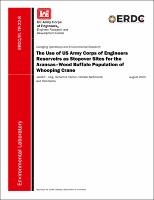Please use this identifier to cite or link to this item:
https://hdl.handle.net/11681/44980Full metadata record
| DC Field | Value | Language |
|---|---|---|
| dc.contributor.author | Jung, Jacob F. | - |
| dc.contributor.author | Fischer, Richard A., Jr., 1964- | - |
| dc.contributor.author | Bates, Pam | en_US |
| dc.contributor.author | McConnell, Chester | - |
| dc.creator | Environmental Laboratory (U.S.) | - |
| dc.date.accessioned | 2022-08-08T13:35:45Z | - |
| dc.date.available | 2022-08-08T13:35:45Z | - |
| dc.date.issued | 2022-08 | - |
| dc.identifier.govdoc | ERDC/EL TR-22-8 | - |
| dc.identifier.uri | https://hdl.handle.net/11681/44980 | - |
| dc.identifier.uri | http://dx.doi.org/10.21079/11681/44980 | - |
| dc.description | Technical Report | en_US |
| dc.description.abstract | This technical report summarizes the use of US Army Corps of Engineers (USACE) reservoirs as spring and fall migration stopover sites for the endangered Aransas–Wood Buffalo population of whooping cranes (WHCR), which proved much greater than previously known. We assessed stopover use within the migration flyway with satellite transmitter data on 68 WHCR during 2009–2018 from a study by the US Geological Survey (USGS) and collaborators, resulting in over 165,000 location records, supplemented by incidental observations from the US Fish and Wildlife Ser-vice (USFWS) and the USGS Biodiversity Information Serving Our Nation (BISON) databases. Significant stopover use was observed during both spring and fall migration, and one reservoir served as a wintering location in multiple years. Future efforts should include (a) continued monitoring for WHCR at USACE reservoirs within the flyway; (b) reservoir-specific management plans at all projects with significant WHCR stopover; (c) a USACE-specific and range-wide Endangered Species Act Section 7(a)(1) conservation plan that specifies proactive conservation actions; (d) habitat management plans that include potential pool-level modifications during spring and fall to optimize stopover habitat conditions; and (e) continued evaluation of habitat conditions at USACE reservoirs. | en_US |
| dc.description.sponsorship | Dredging Operations and Environmental Research Program (U.S.) | en_US |
| dc.description.tableofcontents | Abstract .................................................................................................................................... ii Contents .................................................................................................................................. iii Figures and Tables ................................................................................................................... v Preface .................................................................................................................................... ix 1 Introduction ...................................................................................................................... 1 1.1 Background ......................................................................................................... 1 1.2 Objectives ............................................................................................................ 3 1.3 Approach ............................................................................................................. 3 2 Methods ............................................................................................................................ 9 2.1 Data acquisition .................................................................................................. 9 2.1.1 US Geological Survey (USGS) Telemetry Database ............................... 9 2.1.2 US Fish and Wildlife Service (USFWS) Cooperative Whooping Crane Tracking Project (CWCTP) Database ........................................... 9 2.1.3 USGS Biodiversity Information Serving Our Nation (BISON) Database ............................................................................................... 10 2.1.4 USACE Geospatial Data ........................................................................11 2.2 Identification of USACE reservoirs within the WHCR flyway ........................... 14 3 Results ............................................................................................................................. 17 4 Discussion ....................................................................................................................... 26 5 Future Management Goals and Objectives ................................................................ 28 Bibliography ........................................................................................................................... 30 Appendix A: Summary of WHCR Use at Individual USACE Reservoirs (Arranged from North to South in Migration Corridor) ................................................................. 31 A.1 Lake Sakakawea ............................................................................................... 31 A.2 Lake Oahe ........................................................................................................ 32 A.3 Lake Sharpe ..................................................................................................... 33 A.4 Lake Francis Case ............................................................................................ 35 A.5 Lewis and Clark Lake ....................................................................................... 36 A.6 Harlan County Lake ......................................................................................... 38 A.7 Perry Lake ........................................................................................................ 39 A.8 Milford Lake ...................................................................................................... 41 A.9 Wilson Lake ...................................................................................................... 42 A.10 Kanopolis Lake ............................................................................................... 44 A.11 El Dorado Lake ................................................................................................ 45 A.12 Kaw Lake .......................................................................................................... 47 A.13 Great Salt Plains Lake .................................................................................... 49 A.14 Canton Lake ..................................................................................................... 51 A.15 Waurika Lake .................................................................................................. 53 A.16 Lake Texoma ................................................................................................... 55 A.17 Hugo Lake ........................................................................................................ 57 A.18 Grapevine Lake ............................................................................................... 58 A.19 Benbrooke Lake .............................................................................................. 60 A.20 Whitney Lake .................................................................................................... 61 A.21 Proctor Lake .................................................................................................... 63 A.22 Aquilla Lake ..................................................................................................... 65 A.23 Waco Lake ....................................................................................................... 67 A.24 Belton Lake ..................................................................................................... 68 A.25 Stillhouse Hollow Lake ................................................................................... 70 A.26 Granger Lake ................................................................................................... 72 Appendix B: Additional USACE Reservoirs ........................................................................ 74 Appendix C: US Fish and Wildlife Service Nebraska Ecological Services Whooping Crane Data Use Agreement ....................................................................... 82 Appendix D: Attachment 1 ................................................................................................... 85 Abbreviations ......................................................................................................................... 89 Report Documentation Page (SF 298) ............................................................................... 90 | - |
| dc.format.extent | 102 pages / 17.41 MB | - |
| dc.format.medium | - | |
| dc.language.iso | en_US | en_US |
| dc.publisher | Engineer Research and Development Center (U.S.) | en_US |
| dc.relation.ispartofseries | Technical Report (Engineer Research and Development Center (U.S.)) ; no. ERDC/EL TR-22-8 | - |
| dc.rights | Approved for Public Release; Distribution is Unlimited | - |
| dc.source | This Digital Resource was created in Microsoft Word and Adobe Acrobat | - |
| dc.subject | Endangered species | en_US |
| dc.subject | Wildlife conservation | en_US |
| dc.subject | Whooping crane | en_US |
| dc.subject | Reservoirs | en_US |
| dc.subject | Flyways | en_US |
| dc.subject | Birds--Migration | en_US |
| dc.title | The use of US Army Corps of Engineers reservoirs as stopover sites for the Aransas–Wood Buffalo population of whooping crane | en_US |
| dc.type | Report | en_US |
| Appears in Collections: | Technical Report | |
Files in This Item:
| File | Description | Size | Format | |
|---|---|---|---|---|
| ERDC-EL TR-22-8.pdf | 17.41 MB | Adobe PDF |  View/Open |